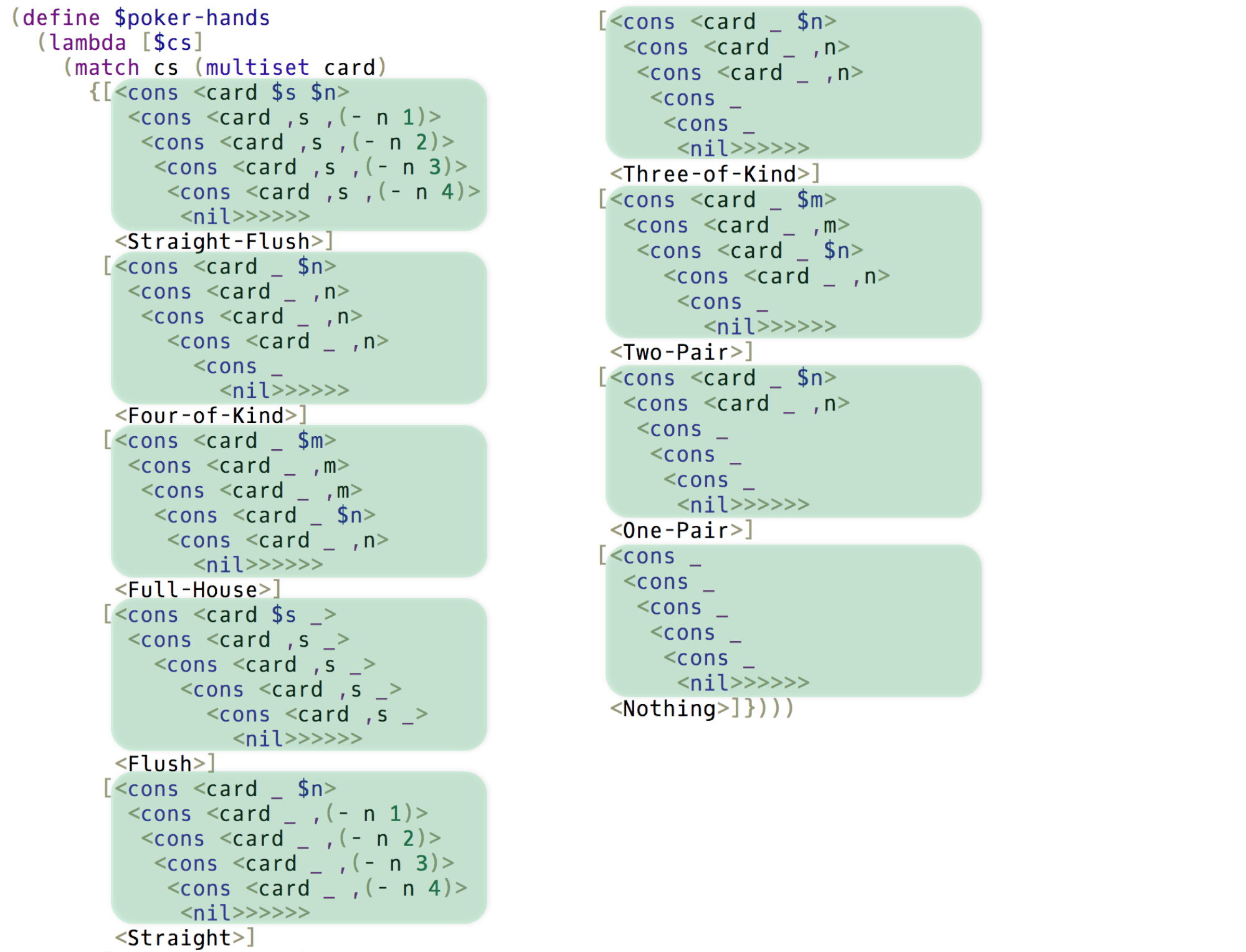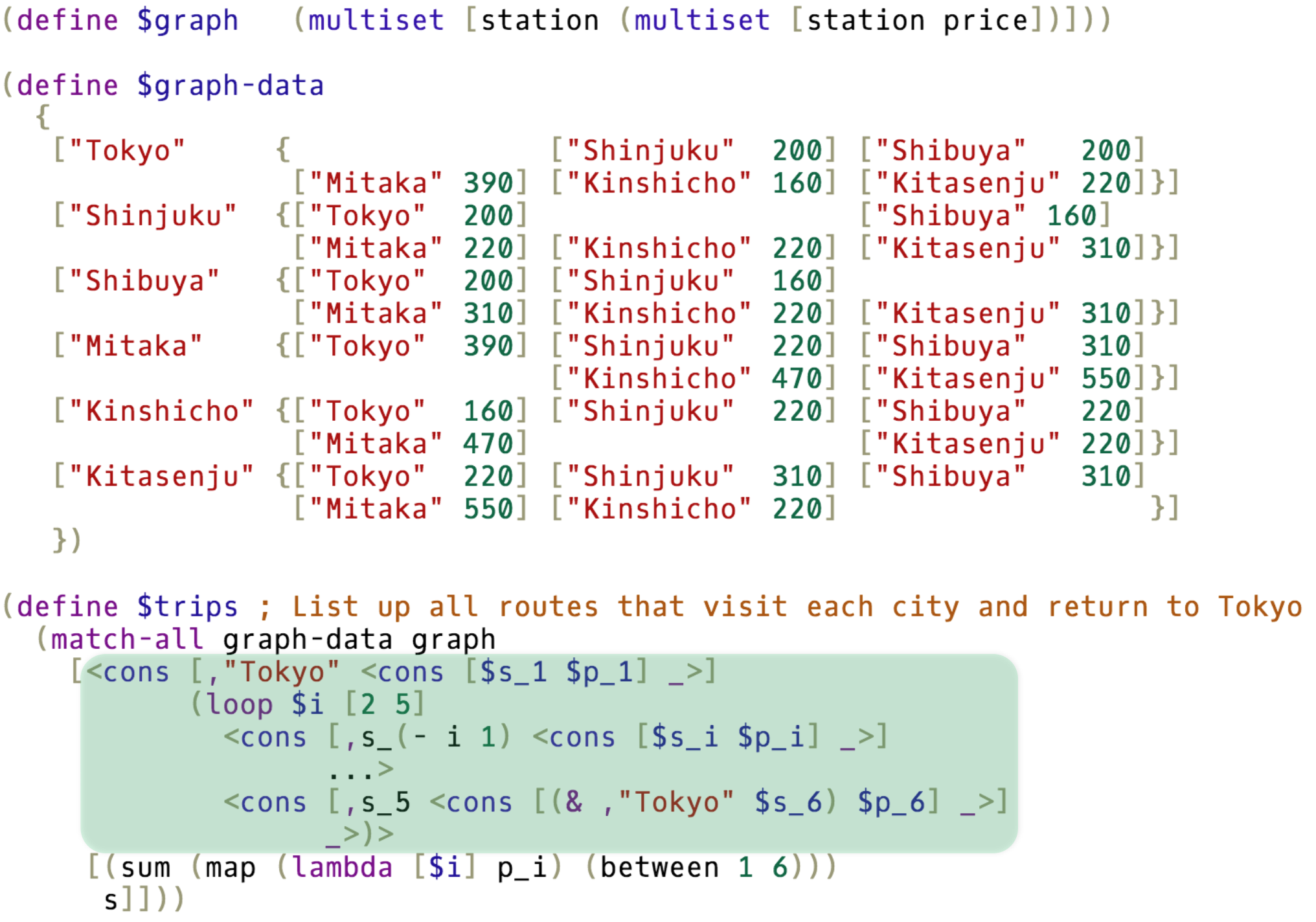Egison is a functional programming language featuring its expressive pattern-matching facility. Egison allows users to define efficient and expressive pattern-matching methods for arbitrary user-defined data types including non-free data types such as lists, multisets, sets, trees, graphs, and mathematical expressions. This is the repository of the interpreter of Egison.
For more information, visit our website.
- Satoshi Egi, Yuichi Nishiwaki: Non-linear Pattern Matching with Backtracking for Non-free Data Types (APLAS 2018)
- Satoshi Egi: Loop Patterns: Extension of Kleene Star Operator for More Expressive Pattern Matching against Arbitrary Data Structures (Scheme Workshop 2018)
- Satoshi Egi: Scalar and Tensor Parameters for Importing Tensor Index Notation including Einstein Summation Notation (Scheme Workshop 2017)
We can describe non-linear pattern matching for non-free data types in Egison. A non-free data type is a data type whose data have no canonical form, a standard way to represent that object. For example, multisets are non-free data types because the multiset {a,b,b} has two other equivalent but literally different forms {b,a,b} and {b,b,a}. Expressive pattern matching for these data types enables us to write elegant programs.
We can use pattern matching for enumeration. The following code enumerates all twin primes from the infinite list of prime numbers with pattern matching!
The following code is the program that determines poker-hands written in Egison. All hands are expressed in a single pattern.
We can write a pattern even against mahjong tiles. We modularize patterns to represent complex mahjong hands.
We can pattern-match against graphs. We can write program to solve the travelling salesman problem in a single pattern-matching expression.
Aren't these exciting? The pattern-matching facility of Egison is very powerful. We can use it for pattern matching also for graphs and tree-structures such as XML.
As an application of Egison pattern matching, we have implemented a computer algebra system on Egison. The most part of this computer algebra system is written in Egison and extensible using Egison.
Egison treats unbound variables as symbols.
> x
x
> (** (+ x y) 2)
(+ x^2 (* 2 x y) y^2)
> (** (+ x y) 10)
(+ x^10 (* 10 x^9 y) (* 45 x^8 y^2) (* 120 x^7 y^3) (* 210 x^6 y^4) (* 252 x^5 y^5) (* 210 x^4 y^6) (* 120 x^3 y^7) (* 45 x^2 y^8) (* 10 x y^9) y^10)
We can handle algebraic numbers, too.
> (sqrt x)
(sqrt x)
> (sqrt 2)
(sqrt 2)
> (sqrt 4)
2
> (+ x (sqrt y))
(+ x (sqrt y))
The symbol i is defined to rewrite i^2 to -1 in Egison library.
> (* i i)
-1
> (* (+ 1 (* 1 i)) (+ 1 (* 1 i)))
(* 2 i)
> (** (+ 1 (* 1 i)) 10)
(* 32 i)
> (* (+ x (* y i)) (+ x (* y i)))
(+ x^2 (* 2 i x y) (* -1 y^2))
The rewriting rule for sqrt is also defined in Egison library.
> (* (sqrt 2) (sqrt 2))
2
> (* (sqrt 6) (sqrt 10))
(* 2 (sqrt 15))
> (sqrt x)
(sqrt x)
> (* (sqrt (* x y)) (sqrt (* 2 x)))
(* x (sqrt 2) (sqrt y))
The following is a sample to calculate the 5th roots of unity.
> (q-f' 1 1 -1)
[(/ (+ -1 (sqrt 5)) 2) (/ (+ -1 (* -1 (sqrt 5))) 2)]
> (define $t (fst (q-f' 1 1 -1)))
> (q-f' 1 (* -1 t) 1)
[(/ (+ -1 (sqrt 5) (sqrt (+ -10 (* -2 (sqrt 5))))) 4) (/ (+ -1 (sqrt 5) (* -1 (sqrt (+ -10 (* -2 (sqrt 5)))))) 4)]
> (define $z (fst (q-f' 1 (* -1 t) 1)))
> z
(/ (+ -1 (sqrt 5) (sqrt (+ -10 (* -2 (sqrt 5))))) 4)
> (** z 5)
1
We can implement differentiation easily in Egison.
> (d/d (** x 3) x)
(* 3 x^2)
> (d/d (** e (* i x)) x)
(* i (** e (* i x)))
> (d/d (d/d (log x) x) x)
(/ -1 x^2)
> (d/d (* (cos x) (sin x)) x)
(+ (* -1 (sin x)^2) (cos x)^2)
The following sample executes Taylor expansion on Egison. We verify Euler's formula in the following sample.
> (take 8 (taylor-expansion (** e (* i x)) x 0))
{1 (* i x) (/ (* -1 x^2) 2) (/ (* -1 i x^3) 6) (/ x^4 24) (/ (* i x^5) 120) (/ (* -1 x^6) 720) (/ (* -1 i x^7) 5040)}
> (take 8 (taylor-expansion (cos x) x 0))
{1 0 (/ (* -1 x^2) 2) 0 (/ x^4 24) 0 (/ (* -1 x^6) 720) 0}
> (take 8 (taylor-expansion (* i (sin x)) x 0))
{0 (* i x) 0 (/ (* -1 i x^3) 6) 0 (/ (* i x^5) 120) 0 (/ (* -1 i x^7) 5040)}
> (take 8 (map2 + (taylor-expansion (cos x) x 0) (taylor-expansion (* i (sin x)) x 0)))
{1 (* i x) (/ (* -1 x^2) 2) (/ (* -1 i x^3) 6) (/ x^4 24) (/ (* i x^5) 120) (/ (* -1 x^6) 720) (/ (* -1 i x^7) 5040)}
Egison supports tesnsor index notation. We can use Einstein notation to express arithmetic operations between tensors.
The method for importing tensor index notation into programming is discussed in Egison tensor paper.
The following sample is from Riemann Curvature Tensor of S2 - Egison Mathematics Notebook.
;; Parameters
(define $x [|θ φ|])
(define $X [|(* r (sin θ) (cos φ)) ; = x
(* r (sin θ) (sin φ)) ; = y
(* r (cos θ)) ; = z
|])
;; Local basis
(define $e_i_j (∂/∂ X_j x~i))
e_i_j
;[|[|(* r (cos θ) (cos φ)) (* r (cos θ) (sin φ)) (* -1 r (sin θ)) |]
; [|(* -1 r (sin θ) (sin φ)) (* r (sin θ) (cos φ)) 0 |]
; |]_#_#
;; Metric tensor
(define $g__ (generate-tensor 2#(V.* e_%1_# e_%2_#) {2 2}))
(define $g~~ (M.inverse g_#_#))
g_#_#;[| [| r^2 0 |] [| 0 (* r^2 (sin θ)^2) |] |]_#_#
g~#~#;[| [| (/ 1 r^2) 0 |] [| 0 (/ 1 (* r^2 (sin θ)^2)) |] |]~#~#
;; Christoffel symbols
(define $Γ_j_k_l
(* (/ 1 2)
(+ (∂/∂ g_j_l x~k)
(∂/∂ g_j_k x~l)
(* -1 (∂/∂ g_k_l x~j)))))
(define $Γ~__ (with-symbols {i} (. g~#~i Γ_i_#_#)))
Γ~1_#_#;[| [| 0 0 |] [| 0 (* -1 (sin θ) (cos θ)) |] |]_#_#
Γ~2_#_#;[| [| 0 (/ (cos θ) (sin θ)) |] [| (/ (cos θ) (sin θ)) 0 |] |]_#_#
;; Riemann curvature tensor
(define $R~i_j_k_l
(with-symbols {m}
(+ (- (∂/∂ Γ~i_j_l x~k) (∂/∂ Γ~i_j_k x~l))
(- (. Γ~m_j_l Γ~i_m_k) (. Γ~m_j_k Γ~i_m_l)))))
R~#_#_1_1;[| [| 0 0 |] [| 0 0 |] |]~#_#
R~#_#_1_2;[| [| 0 (sin θ)^2 |] [| -1 0 |] |]~#_#
R~#_#_2_1;[| [| 0 (* -1 (sin θ)^2) |] [| 1 0 |] |]~#_#
R~#_#_2_2;[| [| 0 0 |] [| 0 0 |] |]~#_#
By designing the index completion rules for omitted indices, we can use the above notation to express a calculation handling the differential forms.
The following sample is from Curvature Form - Egison Mathematics Notebook.
;; Parameters and metric tensor
(define $x [| θ φ |])
(define $g__ [| [| r^2 0 |] [| 0 (* r^2 (sin θ)^2) |] |])
(define $g~~ [| [| (/ 1 r^2) 0 |] [| 0 (/ 1 (* r^2 (sin θ)^2)) |] |])
;; Christoffel symbols
(define $Γ_i_j_k
(* (/ 1 2)
(+ (∂/∂ g_i_k x~j)
(∂/∂ g_i_j x~k)
(* -1 (∂/∂ g_j_k x~i)))))
(define $Γ~i_j_k (with-symbols {m} (. g~i~m Γ_m_j_k)))
;; Connection form
(define $ω~i_j (with-symbols {k} Γ~i_j_k))
;; Curvature form
(define $d
(lambda [%A]
!((flip ∂/∂) x A)))
(define $wedge
(lambda [%X %Y]
!(. X Y)))
(define $Ω~i_j (with-symbols {k}
(df-normalize (+ (d ω~i_j)
(wedge ω~i_k ω~k_j)))))
Here are more samples.
There are a lot of existing work for pattern matching.
The advantage of Egison is that it fulfills the following two requirements at the same time.
- Efficient backtracking algorithm for non-linear pattern matching.
- Extensibility of patterns.
Additionally, it fulfills the following requirements.
- Polymorphism of patterns.
- Pattern matching with infinitely many results.
Please read our paper for details.
If you are using Linux, please install libncurses-dev at first.
% sudo apt-get install libncurses-dev # on Debian
To compile Egison, you also need to install Haskell Platform.
After you installed Haskell Platform, run the following commands on the terminal.
% cabal update
% cabal install egison
Now, you can try Egison.
% egison
Egison Version X.X.X(C) 2011-2014 Satoshi Egi
https://www.egison.org
Welcome to Egison Interpreter!
> ^D
Leaving Egison Interpreter.
If you are a beginner of Egison, it would be better to install egison-tutorial.
% cabal update
% cabal install egison-tutorial
% egison-tutorial
Egison Tutorial Version 3.7.4 (C) 2013-2017 Satoshi Egi
Welcome to Egison Tutorial!
** Information **
We can use a 'Tab' key to complete keywords on the interpreter.
If we type a 'Tab' key after a closed parenthesis, the next closed parenthesis will be completed.
*****************
==============================
List of sections in the tutorial.
1: Calculate numbers
2: Basics of functional programming
3: Basics of pattern matching
4: Pattern matching against various data types
5: Symbolic computation
6: Differential geometry: tensor analysis
7: Differential geometry: differential forms
==============================
Choose a section to learn.
(1-7): 1
====================
We can do arithmetic operations with '+', '-', '*', '/', 'modulo' and 'power'.
Examples:
(+ 1 2)
(- 30 15)
(* 10 20)
(/ 20 5)
(modulo 17 4)
(power 2 10)
====================
>
We can try it also online. Enjoy!
% cabal test
% sudo apt-get install haskell-platform-doc haskell-platform-prof
% cabal sandbox init
% cabal install --enable-profiling
% egison +RTS -p -RTS -l sample/sequence.egi
% cat egison.prof
We have a mailing list. Please join us!
We are on Twitter. Please follow us.
I thank Ryo Tanaka, Takahisa Watanabe, Takuya Kuwahara, Kentaro Honda, and Mayuko Kori for their help to implement the interpreter.
Copyright (c) 2011-2018, Satoshi Egi
Egison is released under the MIT license.
I used husk-scheme by Justin Ethier as reference to implement the base part of the previous version of the interpreter.
Egison is sponsored by Rakuten, Inc. and Rakuten Institute of Technology.



